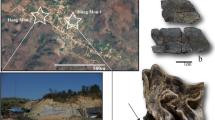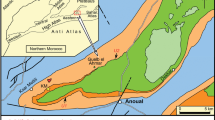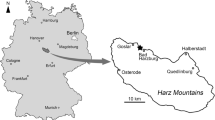Abstract
Neither pre-Cenozoic crown eutherian mammals (placentals) nor archaic ungulates (“condylarths”) are known with certainty based on the fossil record. Herein we report a new species of the Paleocene archaic ungulate (“condylarth”) Protungulatum from undisputed Late Cretaceous aged rocks in Montana USA based on an isolated last upper premolar, indicating rare representatives of these common early Tertiary mammals appeared in North America a minimum of 300 k years before the extinction of non-avian dinosaurs. The other 1200 mammal specimens from the locality are characteristic Late Cretaceous taxa. This discovery overturns the current hypothesis that archaic ungulates did not appear in North America until after the Cretaceous/Tertiary (K/T) boundary and also suggests that other reports of North American Late Cretaceous archaic ungulates may be correct. Recent studies, including ours, cannot determine whether Protungulatum does or does not belong to the crown clade Placentalia.



Similar content being viewed by others
References
Archibald JD (1982) A study of Mammalia and geology across the Cretaceous-Tertiary boundary in Garfield County, Montana. Univ Calif Publ Geol Sci 122:1–286
Archibald JD (1998) Archaic ungulates (“Condylartha”). In: Janis CM, Scott KM, Jacobs LL (eds) Evolution of Tertiary Mammals of North America. Vol. 1, Terrestrial Carnivores, Ungulates, and Ungulatelike Mammals. Cambridge University Press, Cambridge, pp 292–331
Archibald JD (2011) Extinction and Radiation: How the Fall of the Dinosaurs Led to the Rise of Mammals. Johns Hopkins University Press, Baltimore
Belt EB, Hicks JF, Murphy DA (1997) A pre-Lancian regional unconformity and its relationship to Hell Creek paleogeography in south-eastern Montana. Contrib Geol Univ Wyo 31:1–26
Cifelli RL, Eberle JJ, Lofgren DL, Lillegraven JA, Clemens WA (2004) Mammalian biochronology of the latest Cretaceous. In: Woodburne MO (ed) Late Cretaceous and Cenozoic Mammals of North America. Columbia University Press, New York, pp 21–42
Clemens WA (1973) Fossil mammals of the type Lance Formation Wyoming, Part III. Eutheria and summary. Univ Calif Publ Geol Sci 94:1–102
Clemens WA (2002) Evolution of the mammalian fauna across the Cretaceous Tertiary boundary in northeastern Montana and other areas of the Western Interior. Geol Soc Am Spec Pap 361:217–245
Clemens WA (2010) Were immigrants a significant part of the earliest Paleocene mammalian fauna of the North American Western Interior? Vertebr PalAsiatic 48:285–307
Fox RC (1989) The Wounded Knee local fauna and mammalian evolution near the K/T boundary, Saskatchewan, Canada. Palaeontographica Abt A 208:11–59
Fox RC, Naylor BG (2003) A Late Cretaceous taeniodont (Eutheria, Mammalia) from Alberta, Canada. N Jb Geol Paläont Abh 229:393–420
Gradstein F, Ogg J, Smith A (eds) (2004) A Geologic Time Scale. Cambridge University Press, Cambridge
Hicks JF, Johnson KR, Obradovich JD, Tauxe L, Clark D (2002) Magnetostratigraphy and geochronology of the Hell Creek and basal Fort Union formations of southwestern North Dakota and a recalibration of the age of the Cretaceous-Tertiary boundary. Geol Soc Am Spec Pap 361:35–56
Hunter JP, Archibald JD (2002) Mammals from the end of the age of dinosaurs in North Dakota and southeastern Montana, with a reappraisal of geographic differentiation among Lancian mammals. Geol Soc Am Spec Pap 361:191–216
Johnson KR, Hickey LJ (1990) Megafloral change across the Cretaceous/Tertiary boundary in the northern Great Plains and Rocky Mountains, USA. Geol Soc Am Spec Pap 247:433–444
Kass RE, Raftery AE (1995) Bayes factors. J Am Stat Assoc 90:773–795
Kielan-Jaworowska Z, Cifelli RL, Luo Z-X (2004) Mammals from the Age of Dinosaurs: Origins, Evolution, and Structure. Columbia University Press, New York
Lewis PO (2001) A likelihood approach to estimating phylogeny from discrete morphological character data. Syst Biol 50:913–925
Lofgren DL (1995) The Bug Creek problem and the Cretaceous-Tertiary transition at McGuire Creek, Montana. Univ Calif Publ Geol Sci 140:1–185
Lofgren DL, Lillegraven JA, Clemens WA, Gingerich PD, Williamson TE (2004) Paleocene biochronology: the Puercan through the Clarkforkian land mammal ages. In: Woodburne MO (ed) Late Cretaceous and Cenozoic Mammals of North America. Columbia University Press, New York, pp 43–105
Luo Z-X (1991) Variability of dental morphology and the relationships of the earliest arctocyonid species. J Vertebr Paleontol 11:452–471
Nessov LA, Archibald JD, Kielan-Jaworowska Z (1998) Ungulate-like mammals from the Late Cretaceous of Uzbekistan and a phylogenetic analysis of Ungulatomorpha. Bull Carnegie Mus Nat Hist 34:40–88
Prieto-Marquez A (2010) Global phylogeny of Hadrosauridae (Dinosauria: Ornithopoda) using parsimony and Bayesian methods. Zool J Linn Soc 159:435–502
Prothero DR, Manning E, Fischer M (1988) The phylogeny of the ungulates. In: MJ Benton (ed) The Phylogeny and Classification of Tetrapods, Volume 2: Mammals. Syst Assoc Spec 35B:201–234
Rougier GW, Wible JR, Novacek MJ (1998) Implications of Deltatheridium specimens for early marsupial history. Nature 396:459–462
Silcox MT, Bloch JI, Sargis EJ, Boyer DM (2005) Euarchonta (Dermoptera, Scandentia, Primates). In: Rose KD, Archibald JD (eds) The Rise of Placental Mammals: Origins and Relationships of the Major Extant Clades. Johns Hopkins University Press, Baltimore, pp 127–144
Sloan RE, Van Valen L (1965) Cretaceous mammals from Montana. Science 148:220–227
Sloan RE, Rigby JK Jr, Van Valen LM, Gabriel DL (1986) Gradual dinosaur extinction and simultaneous ungulate radiation in the Hell Creek Formation. Science 234:1173–1175
Smit J, Van der Kaars S (1984) Terminal Cretaceous extinctions in the Hell Creek Area, Montana: compatible with catastrophic extinction. Science 223:1177–1179
Spaulding M, O’Leary MA, Gatesy J (2009) Relationships of Cetacea (Artiodactyla) among mammals: increased taxon sampling alters interpretations of key fossils and character evolution. PLoS ONE 4:1–14
Van Valen L (1978) The beginning of the age of mammals. Evol Theory 4:103–121
Weil A, Clemens WA (1998) Aliens in Montana: phylogenetically and biogeographically diverse lineages contributed to an earliest Cenozoic community. Geol Soc Am Absts Prgm 30:69–70
Wible JR, Rougier GW, Novacek MJ, Asher RJ (2007) Cretaceous eutherians and Laurasian origin for placental mammals near the K/T boundary. Nature 447:1003–1006
Wible JR, Rougier GW, Novacek MJ, Asher RJ (2009) The eutherian mammal Maelestes gobiensis from the Late Cretaceous of Mongolia and the phylogeny of Cretaceous Eutheria. Bull Am Mus Nat Hist 327:1–123
Acknowledgements
We thank an anonymous reviewer, A. O. Averianov, W. A. Clemens, J. P. Hunter, and G. P. Wilson, for comments that improved the manuscript. W. A. Clemens and P. Holroyd are thanked for specimen loans from the UCMP, Marshal Hedin for photographic help, and Tod Reeder for systematic help to Tony Harper.
Author information
Authors and Affiliations
Corresponding author
Appendix
Appendix
A reanalysis of the Nexus formatted data matrix compiled by Wible et al. (2009), using the program Mr.BAYES accessed through the Cyberinfrastructure for Phylogenetic Research (CIPRES) portal 2.0 website, was preformed to determine relationships and quantify support values for alternate topologies of the crown group Placentalia, specifically to examine the placental affinities of the latest Cretaceous and/or early Paleocene taxa Protungulatum, Oxyprimus, and Purgatorius. A constrained treesearch was used to force the taxa Protungulatum and Oxyprimus into a clade with the placental ungulates Gujaratia, Hyopsodus, Meniscotherium, and Phenacodus; while the genus Purgatorius was forced into a clade with the primatomorph taxa Plesiadapis, Northarctus, and Adapis. A second treesearch was run completely unconstrained, and the likelihood values of these topologies were compared using a Bayes factors test (Kass and Raftery 1995). All treesearches used the same matrix of 69 taxa and 408 unordered characters and were run for ten million generations with sampling every 1000 generations, generating a stable distribution of parameter estimates. Likelihood values were saved, after a 10% burn in, and used an Mk model of character change with alpha values (rates of evolution) estimated by a Gamma distribution binned into four categories (Lewis 2001; Prieto-Marquez 2010). This distribution of alpha values was chosen over one assuming strictly equal rates of evolution after both types of models were run using the constrained and unconstrained data described above; in both cases the Mk+G models generated significantly higher likelihood values compared to their constant rate counterparts.
The harmonic means of the log likelihood values for both the constrained and unconstrained analyses are, respectively:
-
Constrained + Gamma harmonic mean= −8520.87
-
Unconstrained + Gamma harmonic mean= −8499.48
The large difference between these two values when compared with a Bayes factors test (difference = 42.78) suggests that the unconstrained analysis is truly a better explanation of the data given the model parameters, and that the taxa Purgatorius, Protungulatum, and Oxyprimus cannot confidently be placed inside the crown group Placentalia.
Rights and permissions
About this article
Cite this article
Archibald, J.D., Zhang, Y., Harper, T. et al. Protungulatum, Confirmed Cretaceous Occurrence of an Otherwise Paleocene Eutherian (Placental?) Mammal. J Mammal Evol 18, 153–161 (2011). https://doi.org/10.1007/s10914-011-9162-1
Published:
Issue Date:
DOI: https://doi.org/10.1007/s10914-011-9162-1




